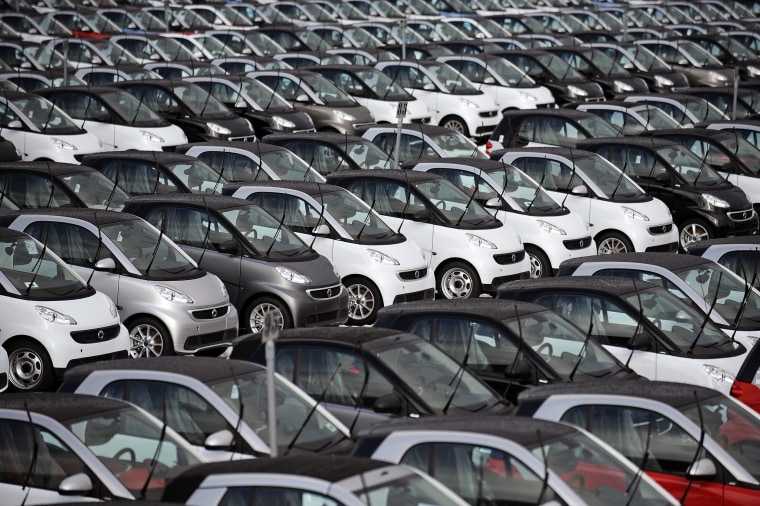If timing is everything, the Smart car brand needs to reset its clock.
The maker of one of the world’s smallest vehicles is launching an all-new version of its pint-sized fortwo model at a time when cheap gas has American motorists buying pickups, SUVs and crossover-utility vehicles in record numbers.
Demand for downsized products like the Mini Cooper and Fiat 500 have been tumbling at double-digit rates in recent months, which could big pose problems for the little Smart car.
Originally launched in 1998 as an alternative for urban drivers around the world, it has never come close to meeting expectations, and company records show it has lost parent Daimler AG at least $5 billion so far.
Nonetheless, brand chief Annette Winkler, one of the highest-ranked women in the European auto industry, is optimistic that “there is much more potential” for Smart with the launch of the fortwo coupe, which will be followed next February by a convertible. A new battery-electric version also is in the works.
Smart move by Swatch
Originally conceived in 1994 as a joint venture between what was then Daimler-Benz AG and the Swiss watch company Swatch, Smart was targeted at buyers in crowded cities like Paris, Rome and New York, where streets are narrow, and parking spots are scarce and tight. To heighten its appeal, the partners also promised to encourage extensive customization by offering such features as swappable, multi-colored body panels.
By the time the first ForTwo hit the road in 1998, Swatch had pulled out of the project and the idea of easily replaceable body panels was abandoned. A U.S. launch, meanwhile, was repeatedly delayed. Smart finally crossed the Atlantic in 2008, when the original microcar was already a decade old.

Initially, U.S. sales were handled by automotive entrepreneur Roger Penske, and the timing appeared much better, the little fortwo arriving at a time when gas prices were surging. The brand sold nearly 20,000 cars during the first year on the market.
But the bubble quickly burst, sales started plummeting and Penske ceded the brand back to parent Daimler. Today, U.S. marketing is handled by the sibling brand Mercedes-Benz.
At a time when the American automotive market is enjoying its most robust sales in a decade, Smart suffered a 67.4 percent year-over-year decline during the first seven months of the year. U.S. buyers drove off with just 441 of the fortwo models in July.
New Jeep Cherokee to Get 707-HP Hellcat Engine, Sources Say
But worldwide demand has surged by 30 percent this year, noted Winkler, to 71,450, with the launch of the second-generation fortwo line.
In a sense, Smart went back to its original playbook, opting to find a partner to develop the newest version of the fortwo. In this case, Daimler’s alliance partner Renault played lead in product development, and a version of the car is being sold as the French maker’s new Twingo microcar.
The new coupe has undergone a number of updates, both visually and technically, though it still looks much like the original. It maintains the first-generation coupe’s miniscule 8-foot length, though it adds about 3 inches in width to give passengers a little more shoulder room. It also gets a more powerful, turbocharged three-cylinder engine and a pair of new transmission options.
“That vehicle makes all the sense in the world in places like Rome. Americans like to pay for their cars by the pound.”
Those changes could address some of the biggest problems with the original Smart fortwo, including sluggish performance and a jerky ride. But there are still some concerns.
“That vehicle makes all the sense in the world in places like Rome,” says David Sullivan, a senior analyst with consulting firm AutoPacific Inc. But the U.S. is another matter entirely, he contends, noting that “Americans like to pay for their cars by the pound.”
At a base price of $15,400, including delivery charges, Sullivan noted, the German microcar is more expensive than some larger vehicles that still get the same, or even better, fuel economy than the 2016 Smart fortwo. It is rated by the EPA at 36 mpg in the “combined” cycle. And unlike most other mini and economy cars, the French-made fortwo requires costly premium fuel.
This Car Just Got Consumer Reports' Highest Rating Ever
Despite such concerns, Winkler and her Smart colleagues remain upbeat, if cautious, about the opportunities the fortwo has in the U.S. They don’t anticipate a major surge in demand, and they expect most growth will come in urban settings where microcars are a better fit. A media ride of the new coupe was staged recently in Portland, Oregon, a fitting choice considering the brand has doubled its presence in the hip and eclectic Pacific Northwest city over the past year.
Smart also plans to reach out to potential buyers by partnering with the car-sharing service Car2Go. It claims satisfied, short-term rental customers have often gone on to buy the minicars.
Analysts like Sullivan contend the brand will have to prove it can reverse years of decline if it hopes to justify its existence. Continuing the losses Smart has run up since its introduction are becoming harder and harder to justify for parent Daimler AG, he said.
But pulling off a turnaround at a time of cheap fuel could depend on the brand not only being Smart, but lucky.
More from The Detroit Bureau
Lawsuit Targets 10 Major Automakers, Claims Deadly Keyless Ignition Defect
Automakers Rapidly Expand Availability of Crash Avoidance Technology